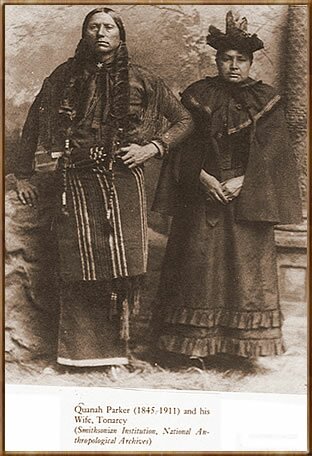Quanah Parker (1845?-1911)

The name Quanah was derived from Comanche kwaina, meaning “fragrant” or “sweet smelling”. Quanah was the son of Peta Nocona, a chief of the warlike Quahadi band, and Cynthia Ann Parker the daughter of a Texas settler who had been captured on May 19, 1836 at the age of nine. Adopted by the band and named Preloch, she lived happily with the Indian people, grew to maturity, and married Nocona. She was recaptured by Texas Rangers in a raid and forcibly returned to her home, where she died (of a broken heart, most accounts say) four years later, still yearning to return to her Comanche world. Quanah himself was born at Cedar Lake, Texas in May 1845.
A strong, fearless youth, Quanah became tribal leader after the death of his father. He formed his own band of raiders, some of whom were the best warriors in the region. They refused to accept the terms of the Medicine Lodge Treaty of 1867 which decreed that the Comanche, along with the Kiowa, Apache, Cheyenne, and Arapaho people, were to be settled in Indian Territory. For the next seven years Quanah lived in open rebellion, raiding frontier towns and White settlers. In 1874 he was in command of a united Indian force of about 700 that attacked a party of buffalo hunters who had been decimating the herds in the area. The hunters were securely protected by the stout fortification of adobe walls in the Texas Panhandle, and though badly outnumbered, they had a cannon which enabled them to turn the tide against the Indians. Quanah and his band were then pursued by General Ranald Mackenzie, and after a two-year harassment, finally surrendered.
At this point, Quanah Parker changed his life remarkably. Setting aside his enmity toward the Whites, he accommodated himself to their civilization, and became a prosperous, settled farmer in Indian Territory. Although he remained loyal to the Comanche traditions of his fathers, he encouraged his people to seek education and to learn the White man’s ways. Through his influence, the confederated tribes leased surplus pasture lands to stock raisers, and thereby gained substantial income. He was appointed judge of the Court of Indian Affairs in 1886 and helped build it into a major force. Indeed, he was successful to a point where factionalism and jealousy within the tribe and White pressures against polygamy combined to cause him to lose his judgeship in 1898.
Quanah traveled widely as a representative of his tribe, and along with Geronimo and several other famed Indian personages of the day, rode in Theodore Roosevelt’s inaugural parade. He had seven wives, two of whom survived him, and three sons and four daughters. He died on February 21, 1911 at the age of 64, in Cache, Oklahoma and was buried beside his mother Cynthia Ann, whose body he had earlier reinterred in Cache.
Source: Great North American Indians by Frederick J. Duckstander